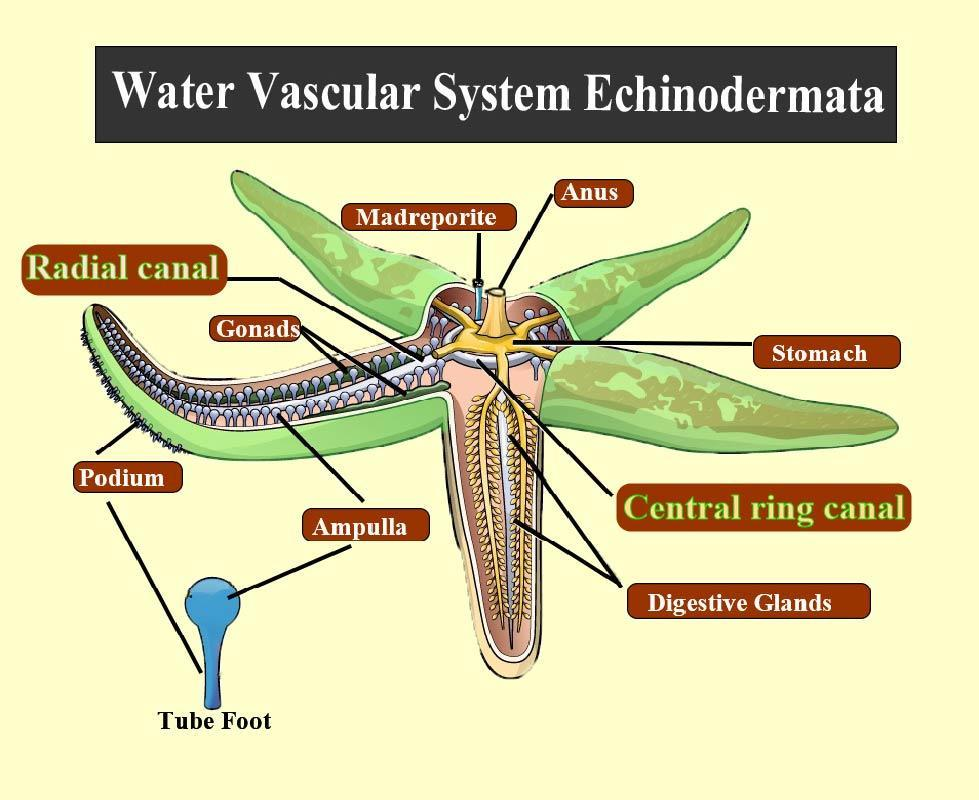
The water vascular system is the characteristic of which group of the following?
(a) Porifera
(b) Ctenophora
(c) Echinodermata
(d) Chordata
Answer
471.9k+ views
Hint: The water vascular system is a hydraulic system for locomotion, food and waste transportation, and respiration, used by sea stars and sea urchins. It is present in a phylum whose spiny skin owes its meaning to its name. These are merely aquatic species.
Complete step by step answer:
A characteristic feature of the phylum Echinodermata is the water vascular system. It consists of an array of channels of radiation, feet of tubes, and madreporite. Echinoderms have a specific ambulacral or water vascular system, consisting of a central ring canal and radial canals running along each arm. Water flows through these systems, enabling gaseous exchange, nutrition, predation, and locomotion.
- Sponges don't have a genuine circulatory system. Sponges have flagellated cells over their body's surface, these are cells that have wiggling tails. The collective effort of all these cells creates a current of water through the many porous openings in the body of the sponge.
- Ctenophora does not have specific circulatory organs. Nor do they have any breathing organs. Over the entire surface of the body, gas exchange and the excretion of waste products of cell metabolism, such as ammonia, occur by simple diffusion.
- Chordata has a closed circulatory system, and the heart pumps blood into the body's cavities. However, most Chordata's circulatory system includes several chambered cores, together with a closed circulatory system that is more developed than any other chordates.

So, the correct answer is, ‘(c) Echinodermata’.
Note: The vessels that carry blood and lymph through the body make up the vascular system. It is also called the circulatory system. Blood is transported through the body by the arteries and veins. They send oxygen and nutrients into the tissues of the body. And they are taking excess of tissue away.
Complete step by step answer:
A characteristic feature of the phylum Echinodermata is the water vascular system. It consists of an array of channels of radiation, feet of tubes, and madreporite. Echinoderms have a specific ambulacral or water vascular system, consisting of a central ring canal and radial canals running along each arm. Water flows through these systems, enabling gaseous exchange, nutrition, predation, and locomotion.
- Sponges don't have a genuine circulatory system. Sponges have flagellated cells over their body's surface, these are cells that have wiggling tails. The collective effort of all these cells creates a current of water through the many porous openings in the body of the sponge.
- Ctenophora does not have specific circulatory organs. Nor do they have any breathing organs. Over the entire surface of the body, gas exchange and the excretion of waste products of cell metabolism, such as ammonia, occur by simple diffusion.
- Chordata has a closed circulatory system, and the heart pumps blood into the body's cavities. However, most Chordata's circulatory system includes several chambered cores, together with a closed circulatory system that is more developed than any other chordates.

So, the correct answer is, ‘(c) Echinodermata’.
Note: The vessels that carry blood and lymph through the body make up the vascular system. It is also called the circulatory system. Blood is transported through the body by the arteries and veins. They send oxygen and nutrients into the tissues of the body. And they are taking excess of tissue away.
Recently Updated Pages
Class 11 Question and Answer - Your Ultimate Solutions Guide

Master Class 11 English: Engaging Questions & Answers for Success

Master Class 11 Computer Science: Engaging Questions & Answers for Success

Master Class 11 Maths: Engaging Questions & Answers for Success

Master Class 11 Social Science: Engaging Questions & Answers for Success

Master Class 11 Economics: Engaging Questions & Answers for Success

Trending doubts
10 examples of friction in our daily life

What problem did Carter face when he reached the mummy class 11 english CBSE

Difference Between Prokaryotic Cells and Eukaryotic Cells

State and prove Bernoullis theorem class 11 physics CBSE

What organs are located on the left side of your body class 11 biology CBSE

Proton was discovered by A Thomson B Rutherford C Chadwick class 11 chemistry CBSE




